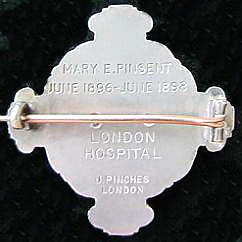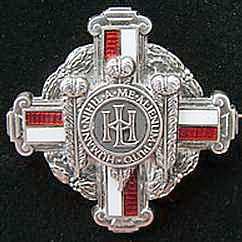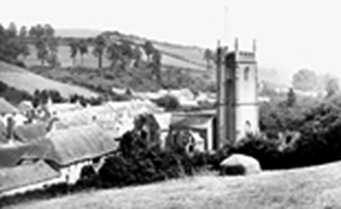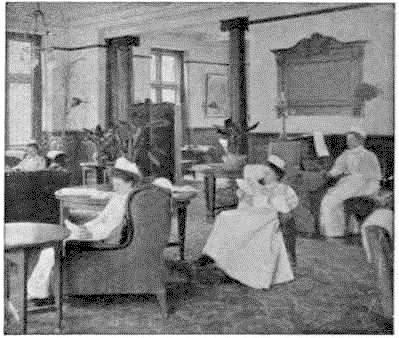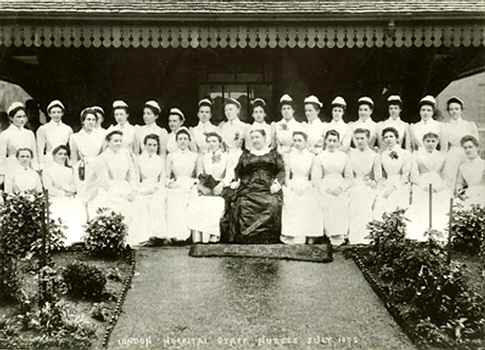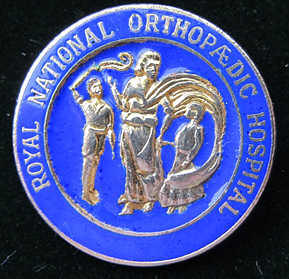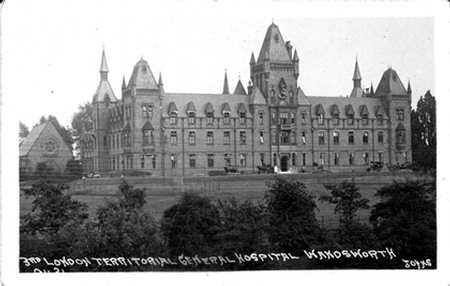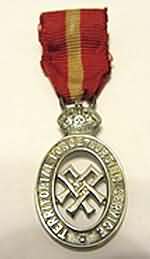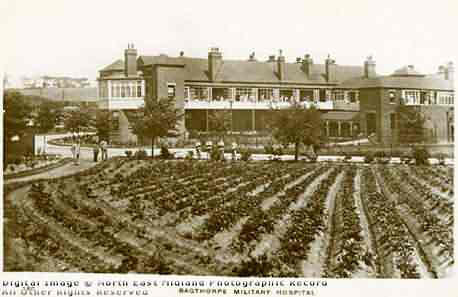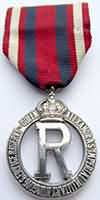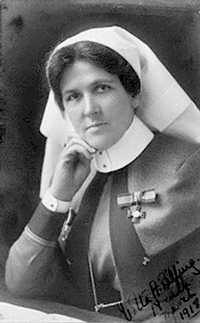|
Collecting Nursing History 18 |
|
Please Note: Whilst every care is taken in checking promoted links, we cannot accept responsibility for your use of third party web links. | |||||||||||||||||||
I became interested in Mary Eliza Pinsent when her badge was sold on Ebay recently and using family history researching skills tried to piece her life together. (NB: It is unusual to find the hospital name engraved on the back) Mary Eliza Pinsent is documented in Miss Luckes register of probationers training (1) as having entered Tredegar House, Bow Road, on June 19th 1896 aged 27 years, with her previous occupation being that of a governess.
The search for more information about Mary was beset with the usual family history/ research problems: · enumerator error(poor hand writing, not writing fully family relationships down e.g. just using "visitor" when a more specific explanation would help i.e. niece/granddaughter) , · transcription errors, Teignhead becoming Minehead, and (1891 census), and Pinsent becoming Phisent(1911 census) · more than 1 person with same name and approximate age in the register of births
ps : Will would a small family tree help?... not sure how to do one in word?, but could try , sarah Birth Using that information, Mary Eliza Pinsent was found as being a governess in 1891 in Liskeard for a farming family, with 3 children ranging from 9 - 5 years. Her birth place was recorded as Teignhead , Devon (although as is often the way it was wrongly transcribed to Minehead, but enlarging the writing helped) and her age was given as 22 years which tallies with her age being given as 27 when starting her training at The London five years later. Using this information it was possible to go backwards and look for more census returns, namely those of 1871 and 1881. Sadly (from a research view point) on each she is not with her parents, in 1871 she is a "visitor" aged 2 along with a 4 year old Catherine A. Pinsent, visiting another Pinsent farming family (possibly her paternal uncle), with her birth place being given as Coombeinteignhead. However the little 4 year old Catherine with whom she was visiting at the time of the 1871 census, does reappear 10 years later on the 1881 census with parents. Looking at these potential parents, a John Pinsent and his wife Catherine it would appear that in 1871 the probable reason for 2 of their offspring being elsewhere was that Catherine (senior/ Marys mother ) had just given birth to, an unnamed (on the census) infant daughter, just 3 days old. There was a 1 year old still in the house, this girl Lucy shows up on the 1881 census with her sister Catherine.
Ten years later on the 1881 census Mary Eliza is a boarder staying
with George Whitborne (also a farmer) whom using information on free
web sites like FreeBMD, and a family tree posted on Ancestry is
almost certainly her maternal grandfather, and again birth place and
age fit with approx 1869.
All the people that Mary lived with appear to have been farmers,
described on the census's variously as farmers/ employing "1/2 man
and 3-4 boys" and various other amounts of men. This
Nurse Training Within 5 years of the 1891 census (in which she is recorded as living in Liskeard as a governess Mary is living in Whitechapel , training to be a nurse as a non paying probationer- as appose to being a paying probationer
"Two
classes of Probationers are accepted for training-Paying and Regular
Probationers. Paying Probationers, who should be between 22 and 40
years of age, are admitted for periods of 3 months on payment in
advance of 13 guineas, to cover everything and an allowance up to 2s
6d. a week is made to them for washing in the Hospital Laundry.
These engagements may be renewed indefinitely upon the same terms
according to mutual agreement. No difference is made in work,
status, or accommodation between paying and regular probationers
except that the former are not required to take night duty unless
they express a wish to do so. By special arrangement, a paying
probationer who is in the limit of age(22 to 33 years) may, after a
period of training, be transferred to the list of regular
probationers. Paying probationers attend all lectures and may sit
for the examinations, but they do not receive any certificate for
less than 2 years training, and then only if they have done the term
of night duty which may be required of them." (33) Many hospitals had paying probationers to help raise much needed funds, rewarding them with much shortened training: St Bartholomew's had "By 1896 the nursing staff numbered 205, made up of 71 first year probationers, 107 staff nurses and staff probationers (second and third year), and 27 paying probationers" (35) Ethel Fenwick (nee Manson) was one such paying probationer: "Born in 1857 into a wealthy, cultured family, and raised near Nottingham, nursing was not regarded as a first choice occupation for a young lady like Ethel. Yet she appears to have been determined to pursue this path from an early age and, at 21, entered training as a pay probationer nurse at Nottingham Children’s Hospital. She left soon after for London, working at Whitechapel and Richmond, before arriving at Bart's in 1881, almost certainly the hospital’s youngest ever matron." recruited trainee nurses from a wider social and geographical sphere than before and introduced special probationers – ladies of ‘superior’ class who could train for three months on payment of a fee..." (36) Mrs Fenwick was a prime supporter of Nurses registration and a three year training - as appose to Miss Luckes who supported a 2 years programme. Monica Baly supports this theory "most teaching hospitals had nurse-training schools; some, without the advantages of a special fund, relied on a proportion of paying probationers, who were attracted to nursing because of the changing status of hospitals and the dearth of respectable jobs for the growing body of educated women seeking emancipation from the home and from lives of busy idleness.... Florence Nightingale looked to the day when probationers would be regarded, like medical students, as primarily there for a learning experience. Thus was born the idea of "Special probationers," who would pay for their board and lodging while, it was hoped, they were being groomed for superintendence." (37)
Presumably the extra pay earlier on made up for the high cost of
training as a paying probationer?
The probationers training "log" also lists particular types of patient care that she covered (oopherectomy being one) Miss Luckes (Matron of The London Hospital 1880-1919) appears to be critical about many of her probationer nurses (including the famous Miss Edith Cavell-1865-1915) and wrote the following on Mary's completion of her training: "Mary Eliza Pinsent was a fairly good probationer and improved very much towards the latter part of her training. She was twice reported for carelessness in the earlier days and needed a good deal of training to make her sufficiently business like over her work. She was punctual, very kind to her patients and she worked pleasantly with others. She was rather a weak character, easily influenced but thoroughly well intentioned. She learnt to manage a ward fairly well. I had a vacancy for staff nurses for which she appeared at the end of her training and her name has now been entered in the nurses register at page 201." E.C.E.L. Sick room cookery cert 1st grade Exam-satisfactory work-satisfactory
Conduct-very good. Life as a Qualified Nurse Mary Eliza Pinsent was appt Nurse Cotton on July 29th 1898, the ward sister being a Miss Warmesly. Mary left the London Hospital on January 1st 1900 to join Miss Warmesly at the Royal Orthopaedic Hospital as a sister, with Miss Warmesly as Matron. Edith Luckes is sparing with her praise!: "Miss Warmesly is anxious to take her with her as sister. The duties of sister at this hospital are far less responsible than those of staff nurse at the London. it was pleasant to know that Mary E. Pinsent would be instrumental in introducing a good standard and affording Miss Warmesly loyal supporting the difficult task of reorganizing a small special hospital with an unenviable reputation" !
(27)© The Royal London Hospital Archives Miss Warmesly didn't stay long -by 1902 Miss Warmsley is no longer recorded as being matron, when Burdett's records Miss Pinsent as being matron3. and Mary is found in the nursing press in 1901 "Miss M. E. Pinsent has been appointed Matron of the Royal Orthopaedic Hospital, Hanover Square, W. Miss Pinsent was trained at the London Hospital, and has held the position of Sister for the past eighteen. months in the hospital," (16) in 1906 Miss Pinsent's appointment of matron at the amalgamated Royal Orthopaedic Hospital and the National Orthopaedic Hospital is announced in the British journal of Nursing (4) , with the Lady superintendent being a Miss Hole (previously the matron from the National Orthopaedic), and from 1907-1916 Mary is the Lady Superintendant at the newly rebuilt Royal National orthopaedic Hospital.(4)
Miss Pinsent is recorded on the 1911 census living in the nurses home in Hanover sq.(incorrectly spelt so finding her was harder- "phisent"!) and in Burdett's until 1927 ( with a staff of 9 sisters, 2 nurses and 12 probationers, the Royal National Orthopaedic hospital Stanmore hill the "Country branch" having opened at Broadley, Stanmore in 1922). From 1916 to 1921 she is shown as having an acting matron a Miss Gertrude Waddingham; I thought at first perhaps Miss Pinsent was unwell- at this stage she was a mere 50 years young: plenty of my ancestors died at younger ages than that at that period! But as it transpires she was on active service in Nottingham. I had also hoped to find a picture of Mary but the newly deposited RNOH records at the London Metropolitan Archives appear to have little photographic records. Using other research methods (the RCN archivist has been most helpful), and "Googling" , Marys name came up several times in the Nursing Press and London Gazette in that period. Mary appears to be a member of the Matrons council of Great Britain and Ireland and in December 1909 was a reception to welcome back as Matron of Guys Hospital Miss L. V. Haughton; this was held in St Bartholomew's Hospital Nurses sitting room. The list of notable London matrons reads like a who's who in Nursing, with one notable exception: that of Miss Eva Luckes.(24) War Service In 1911 Mary was given the chance to witness personally the Coronation Procession of King George V and Queen Mary on June the 22nd , being chosen as a member of the Territorial Nursing Service: "Territorial Nurses and the Coronation. The following members of the Territorial Force Nursing Service have been allotted places to view the Coronation Procession and the Royal Progress. The selection was by ballot.... No. 3 GENERAL HOSPITAL. Coronation Procession, June 23nd. Principal Matron: Miss E. Barton, Chelsea Infirmary. Four members: (1) Miss Pinsent, Matron, Royal National Orthopaedic Hospital, Matron T.F.N.S." (17) Sceptics among us, when reading the list of members from each hospital, which reads as a list of the great and good from the territorial hospitals might wonder what rank a nurse had to be in order to be entered into the "ballot"! In 1912 Mary is enjoying an at home "given by the then Lord Chancellor Lord Haldane at his home, 28 Queen Anne's Gate to meet the Matrons of the Territorial Force Nursing service. A whole 1/2 page of description of the houses furnishings, and setting is given up to this soiree!, among the prose a delightful description of the uniform the nurses wore: "The matrons wore the uniform of the T.F.N.S.-soft grey gown and cape bound with scarlet, graceful white ‘‘ handkerchief” cap, and badges, and cunning little silver T’s” on the corner of capes." (18) On further research copies of her medal rolls were found, and this led to her service records being obtained online from Kew.5.6. Having felt that this explained her absence (after 1914 -1919, with an acting matron at RNOH ) and subsequent return to the Royal National Orthopaedic Hospital, I took the plunge and downloaded her service records, which give a few personal details within which help to corroborate that I was still researching the correct Mary E Pinsent. Whilst the medal card is sparse in it detail, it reveals that Mary Eliza Pinsent was a matron within the Queen Alexandra's Imperial Military Nursing Service reserve (Q.A.I.M.N.S.R.) , with her 1st "theatre " of war listed as being Egypt, from 19th June 1916, appearing to have been decorated with both the British and Victory Medals for the Q.A.I.M.N.S.R. being listed as being on the "nurses 2" category.5 Her service records are 27 pages long, in which she gives her "nearest relative" as a Mrs H J May (sister: Lucy Whidorne Pinsent married a Harry John May in Romsey reg district in December quarter 1888)7. (note Whidorne not Whitborne, I assume this is transcribers/ or clergy error, but without a certificate I cannot confirm 100%).-but a Harry J May witnessed her signature on her contract with the War Department for this new role. Mary left As early as 1908 there were meetings in London to establish a territorial Army Nursing service, which many major hospitals helped staff "Prior to the Territorial and Reserve Forces Act of 1907, there had been no national medical or nursing service dedicated to the care of the volunteer army. The regular army had been supported by the Army Medical Service, together with Queen Alexandra's Imperial Military Nursing Service, who employed less than 300 nurses to provide nursing care in military hospitals at home and abroad. The Act made provision for the first time for both medical and nursing support to be available to the new force. Lord Haldane took the first steps in establishing the Territorial Force Nursing Service in March 1908, when he invited twelve women to form a Territorial Nursing Council; six were ladies of high standing, including his sister Elizabeth, and the other six were eminent London matrons. The new Matron-in-Chief of the service was Sidney Browne, who had retired from a similar position in QAIMNS in 1906, and the group met for the first time at the War Office on the16th June 1908 to discuss the steps to be taken to form a nursing service for the Territorial Force. (8/ 11) On September 5th 1914 The British journal of nursing ran this article: THE GENERAL HOSPITALS T.F,N.S, "We are officially informed that the Territorial ' Force Nursing Service has now all been mobilized ; and its members have either been called up, or been warned to hold themselves in readiness. The Territorial Force Hospitals are formed in the greater number of towns ; and a large number of beds are in readiness to receive any wounded- the medical staff and nurses are in the hospital's..... MATRONS. London.-No. I, Miss M. Acton, Miss M. Rundle ; No. 2, Miss M.S. Riddell ; No. 3, Miss E. Holden, Miss M. Pinsent " (21) Mary was mobilized for duty in the TF N S on 6 august 1914(6) , and in October met the King and Queen: "The King and Queen, who have shown their solicitude for the sick and wounded by visiting many of them during the past week, on Tuesday paid a surprise visit to the third London General Hospital (Territorial Force), at Wandsworth. Their Majesties were received by Colonel Bruce Porter, the Commanding Officer, who presented
Miss Barton (the Principal Matron), Miss Holden (the Matron), and
Miss Pinsent (the Assistant Matron). The visit extended over nearly
two hours, as the Royal visitors spoke to every patient, giving much
pleasure thereby."
(23)
By 1916 Mary was working at The Military Hospital Bagthorpe Nottingham, formerly Bagthorpe workhouse and infirmary. In 1909 it lost the "workhouse" tag and in 1935 became part of City hospital .
c) Picture the Past
www.picturethepast.org.uk.
photo : L .Cripwell On the website Scartletfinders there are ten hospitals listed for Nottingham in 1917,8 In a copy of her letter to : The officer in charge , at the Military Hospital, Nottingham is held in her service records.6 this she requests to forward her resignation from "The Territorial Force Nursing Service, ... as I am being enrolled in the Q.A.I.M.N.S.R. for duty in Egypt" (6) At that stage she is documented as having been awarded the Royal Red Cross 1st class medal, and is listed in the London Gazette on 3rd June 1916(9) as being a member of the Territorial Force Nursing Service (but attached to the Q.A.I.M.N.S.R). In 1916 she is mentioned twice in the the British Journal of Nursing, firstly in the birthday honours as receiving the 1st class RRC, "IN RECOGNITION OF VALUABLE SERVICES IN CONNECTION WITH THE WAR.... Territorial FORCE NURSING SERVICE. - Matrons: M. Pinsent (attd. Q.A.I.M.N.S. Res.)"(25) and secondly a week later in "Who's Who" is a description of the role of the nurses to whom the Royal Red Cross had been awarded: "MISS PINSENT was the alternative Matron of the Third London General Hospital, and is now attached to Q.A.1.M.N.S. Reserve" (19) It would be wonderful to find a photo of her with this badge, which was presented by the Duke of Connaught in Alexandria on 9th march 1918 (a 2x grt granddad of mine was the governor of Arthur, Duke of Connaught) The Royal Red Cross is awarded
"for exceptional devotion and competency in the performance of
actual nursing duties."(10)
Perhaps Miss Luckes would have been pleased by this recognition for
one of her previous probationers?
Within her war service records is a casualty form for active service barely filling one sheet and has as the 1st entry citing that " Adm: lacerated wound of finger (severe)", at Alex. (Abbreviation for Alexandria, Egypt). Mary is finally recorded as joining for temporary duty on 31 July 1916, approximately 2 weeks later, being discharged from hospital to duty with "Orwa-el-waska sector."- number 26 Stationary Hospital (6)Given that this was before the discovery of penicillin, the risk of infection to such a wound was large, especially in a field/war environment in an area of the world well known for tropical diseases.
After this Mary appears to have received approximately 14 days local
leave (Alexandria) , in August 1918 and was on the sick list for 1
month in October 1918. In a "confidential Report" about her ,
written by Major T walcot, RAMC on 14th may 1919, she has worked on
H.M.A.T. "assaye" from 2nd nov 1918. , she was "zealous in attending
to the comfort of her patients"
Without a picture of Mary in her uniform we may not be able to tell definitively what she would have worn. Sue Light the owner of Scartletfinders(8) an authority on nursing in the great war suggests that Mary would have continued to wear the uniform of a Territorial Nursing Force Matron, although she did actually resign from her post in the TFNS(R) in order to join the Queen Alexandra's Imperial nursing service (reserve)and later at the end of the war resigned from the QAIMNS(R) . In her service record it lists her as Matron, as appose to assistant or acting matron .
T.F.N.S. MATRON
Q.A.I.M.N.S. RESERVE NURSING SISTER
continued; Grey dresses of ‘washing’ material for normal ward wear, grey cape with scarlet facings and white cuffs and white muslin cap. Two scarlet bands, one inch wide worn on the lower arm above the cuff. Silver service badge, circular with letter ‘R’ in the centre, worn in the right lapel of the cape.
The hospital ship HMHS Assaye preparing to leave Alexandria to sail
to England Nurses walk along a street near the wharves after leaving the hospital ship HMHS Assaye in Mudros Harbour. (Donor P. McCarthy)
(You do not have to seek permission to use the Memorial's images for your personal, non-commercial use or use within your organisation. You must seek permission to use the Memorial's images for commercial publication) THE HOSPITAL SHIP HMHS ASSAYE AFTER ARRIVING FROM HAIFA. THE FIRST TRANSPORT BY WATER OF CASUALTIES FROM PALESTINE
(You do not have to seek permission to use the Memorial's images for your personal, non-commercial use or use within your organisation. You must seek permission to use the Memorial's images for commercial publication) Shortly after this, Mary tenders her resignation "as soon as possible after Peace is signed to return to my civilian post " her dispersal certificate being signed on 11th July 1919-but not before she was mentioned in despatches and as being a member of the Territorial Nursing Force Reserve. (20)
The following despatch has been, received by the Secretary of State' for War from General Sir E. H. H. Allenby, G.C.B., G.C.M.G., Commander -in-Chief, Egyptian Expeditionary Force:— . General Headquarters,5th March, 1919. Sir, I have the honour to forward herewith a list of Officers, Nurses, Other Ranks and Civilians, whom I consider worthy of mention for their services during the period from the 19th September, 1918, to the 31st January, 1919. I have the honour to be, Sir, most obedient servant, H. H. ALLENBY, , General. Commander-in-Chief, Egyptian Expeditionary Force." (22)
The only other personal correspondence within this file is a series of letters to and from Mary to the war office about some lost items; "shirt long 1 pair shoes 2nd pair shoes 1 bath towel 1 grey dress, amounting to £4.16.6d"
The war office eventually refuses to pay after several letters in
correspondence, as she has been demobilized and no longer needs
these items for active service, and that they "aren't responsible
for lost kit", which seems rather harsh as that amount would be
worth in 2010,
anything from for lost kit", which seems rather harsh as that
amount would be worth in 2010,
anything from service.
service
(31)
Retirement/post war
After the war Mary returns to the Royal National Orthopaedic hospital, with her job title changing in a copy of 1924's Burdett's (3)(none available for 1922/23 in the archives used) to that of Matron which may have coincided with the country branch opening in July 1922: although staffing numbers and patient numbers remain more or less static until 1927 when her staffing numbers drop from 14 sisters to 9, from 6 nurses to 2, and from 26 probationers to 12. Mary thereafter shows up on electoral roll registers (1924- 27- 29- 30-31- 32 )living at 234 great Portland street,-the address for the nurses home of the Royal National Orthopaedic Hospital) and also on cruises in June 1932, showing her disembarking at London from Gibraltar having travelled 1st class, and recording her address as the Royal National , and occupation as Matron and in 1933 she is shown as disembarking at Southampton having returned from Genoa , this time second class, but with no occupation shown. She is on the 1933 members list for the London Hospital League of Nurses as retired and living in The Grey House Chudleigh, Devon and by 1941 has moved to Torquay, and is living in Sheddon Hall Hotel (her nephew Lionel who inherited some of her savings lived in The Burlington Hotel , Babbacoombe road, Torquay on her death 20 years later) There are not any other members lists for the league in the Archives used.
A Group of London Hospital Nurses League Members 1933- on a trip to an International Nurses Conference in Paris- Mary is not in the party. © The Royal London Hospital Archives There are no Burdett's after this period and she appears to not be registered to vote in London, which suggests that she had moved away, possibly retiring then aged 63. Her death is recorded in Devon in 1960, dying in Seaway Nursing Home, Torquay in March 1960, of Cerebral degeneration,cerebral thrombosis and arterio-sclerosis.-let's hope that she was given the same level excellent nursing care instilled in her at the London. In her will she left an estate of £10,201, 15 s 3d to be shared by her nephew Lionel Read ,The First Church of Christ the Scientist, Torquay and along with £500 " all my jewellery wearing apparel and other personal chattels" (29) to a Kitty May *. In 2010, the relative value of £10,201 0s 0d from 1960 ranges from £179,000.00 to £573,000.00.(13) (NB: * Kitty May appears to be Mary,s neice- in -law, the wife of her other nephew Cyril Phillip May.) To conclude: Mary must have bought her LH badge from 1933 onwards as a member of the LH league when the smaller size was introduced (to league members only)..did she travel up from Devon to annual reviews? Researching Mary has thrown up many common research conundrums, and some new; she was unmarried in 1932-electoral rolls point this out, in common with all nurses at that period, so appears to have no direct descendants that we can find and whilst initially appears to have been forgotten by her family- she was talked about by one of nephews after her death (but ironically not the one who registered her death) . There is now hope that a niece in law does have a photo of her somewhere ! But there are as many unanswered questions as there are answers: what was she like as a matron, what did she do in her last years, she is now shown on 1 Pinsent family tree, since I made contact with them...did she visit her family ? what did she do in her retirement, after 36 +years in London, including living through the 1st world war and abroad in Egypt from 1916-1919 all a far cry from her early life in rural Devon. Her story is probably no different to those of thousands of other such nurses, who never married, and gave their life to nursing.
Acknowledgements: with many thanks to all those people who answered my many email questions in particular : Will Burgess, for proof reading, editing and encouragement.. Dr Anne Cameron, Archives Assistant, Royal College of Nursing Archives. Sue Light, www:Scarletfinders The archivists at: The Royal London Hospital Archives, London Metropolitan Archives, RCN Archives And, lastly but not least my long suffering husband, Harry. References: 1 : probationers records vol 1 . ref . 2. Tredegar house , bow, home of the Preliminary training school, ... and where I had my DN interview in 1986! 2: Miss luckes, letters to her nurses vol 1. 3. 1896-1927 Burdett's Hospitals and Charities, editor Sir Henry Burdett 4. British journal of nursing 17 march 1906 pg 218 5. National archives kew: MARY E PINSENT MEDAL CARD 6. National archives kew: MARY E PINSENT service records 7. FreeBMD: http://www.freebmd.org.uk/ 8. http://www.scarletfinders.co.uk/170.html 9. London Gazette 3 June 1916, issue 5601. 10. http://webarchive.nationalarchives.gov.uk/+/http://www.operations.mod.uk/honours/honours.htm 11. The National Archives, WO32/21715, Formation of Territorial Force Nursing Service 12. http://trove.nla.gov.au/work/165042730?q=assaye&c=picture&versionId=179890317 13. http://www.measuringworth.com/ukcompare/relativevalue.php 14. http://www.picturethepast.org.uk Photo: L Cripwell 15. http://www.sallysbadges.com/shop.php 16. http://rcnarchive.rcn.org.uk/data/VOLUME027-1901/page106-volume27-10thaugust1901.pdf 17. http://rcnarchive.rcn.org.uk/data/VOLUME046-1911/page435-volume46-03rdjune1911. 18. http://rcnarchive.rcn.org.uk/data/VOLUME049-1912/page098-volume49-3rdaugust1912 19. http://rcnarchive.rcn.org.uk/data/VOLUME056-1916/page515-volume56-17thjune1916.pdf 20. http://www.london-gazette.co.uk/issues/31383/supplements/7188 21. http://rcnarchive.rcn.org.uk/data/VOLUME053-1914/page188-volume53-5thseptember1914.pdf 22. http://www.london-gazette.co.uk/issues/31383/supplements/7171 23. http://www.rcnarchive.rcn.org: The British Journal of Nursing , october 10 1914 pg 285 24. http://www.rcnarchive.rc.org: The British Journal of Nursing , december 11 1909 pg 474 25. http://www.rcnarchive.rcn.org:The British Journal of Nursing , june 10 1916 pg 495 26. © The Royal London Hospital Archives 27. © The Royal London Hospital Archives 28. © The Royal London Hospital Archives 29. © www.theprobateservice.gov.uk:leeds probate registry 30. © GRo Birth certificate number BXCF 557280 31. Photograph of authors property 32. © Private Collection
33.
1905-7th edition, Edited by Sir Henry Burdett "How to Become a
Nurse, How and Where to 34. 1910 Morris. E.W. "The London Hospital " pub Arnold. 35. www.rcn.org.uk/__data/assets/file/.../Isla_Stewart_ch3_BoN.rtf 36. http://www.bartsandthelondon.nhs.uk/assets/docs/the_vault_-_ethel_gordon_manson_-_december_07.pdf 37. http://www.humanehealthcare.com/Article.asp?art_id=211 38. Alfred Barnard :Occupations For Women No. 2.- Nursing As A Profession.
39
jobs: knew -? British library gnc reg forms, see when she last worked torquy?,....see if local archives holds anything: photos electoral roll forms photo...see family member can find photo? lama : archives, wages, minutes , ? anything about her..gap when not there? imp war museum? photos in albums of egypt
|
SECTION
1 SECTION 2 |
||||||||||||||||||||
|
Home Schools Region Forum Collecting Galleries History Bibliography News Archive Contact |


